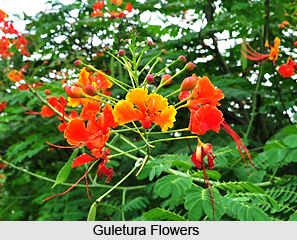Guletura is an exotic, drought-resistant shrub or small tree up to 5 m tall. The entire plant is used for medicinal purposes.
 The branchlets of Guletura are glossy, unarmed or armed with a few straight prickles. Leaves are large, bipinnate, either unarmed or armed with a few prickles paired at the base of pinnae. The flowers are borne in terminal and axillary, pyramidal racemes 20-50 cm long, rarely armed with a few straight prickles. The petals are round, crisped, yellow, orange-red or red in colour with a yellow border and long red or yellow filaments. Fruits (pods) are woody, thin, beaked, ligulate, up to 8 cm long and are 8-10-seeded which are rectangular and black. Flowers come out during September-November and fruits March-April. The botanical name of this plant is Caesalpinia pulcherima (L.) Sw.
The branchlets of Guletura are glossy, unarmed or armed with a few straight prickles. Leaves are large, bipinnate, either unarmed or armed with a few prickles paired at the base of pinnae. The flowers are borne in terminal and axillary, pyramidal racemes 20-50 cm long, rarely armed with a few straight prickles. The petals are round, crisped, yellow, orange-red or red in colour with a yellow border and long red or yellow filaments. Fruits (pods) are woody, thin, beaked, ligulate, up to 8 cm long and are 8-10-seeded which are rectangular and black. Flowers come out during September-November and fruits March-April. The botanical name of this plant is Caesalpinia pulcherima (L.) Sw.
Moreover, Guletura is also known as Barbados pride in English, galtora in Gujarati, Krishnachura in Bengali, Krishnochuda in Oriya and Padandam in Sanskrit. It is presumed that this plant is native to tropical America but widely distributed throughout the tropics and sub tropics. Cultivated throughout India in gardens; occasionally naturalized.
An infusion of the Guletura flowers is used as a pectoral and febrifuge, and in the treatment of bronchitis, asthma, intestinal worms and malarial fevers. The leaves are purgative, tonic and emmenagogue. The bark is highly astringent, and used as an abortifacient and emmenagogue. The powdered seeds are reportedly a remedy for stomachache.



















